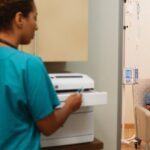Earth Day 2024: Our planet prefers TIVA anaesthesia—do you?
Healthcare’s climate footprint is equivalent to 4.4% of global net emissions; this means that if the health sector were a country, it’d be the 5th largest emitter on the planet.1 We all have a critical role to play in reducing the environmental impact of our clinical practices, without adversely affecting patient outcomes.
For Earth Day on 22nd April, discover how your anaesthesia practices are impacting the planet, and make a conscious choice for a more sustainable future.
More on this topic: 3 ways that BD is fighting climate change
Inhaled anaesthesia creates a significant ecological burden
Did you know volatile and gaseous anaesthesia makes up 5% of the United Kingdom’s total greenhouse gas emissions?2
Inhaled anaesthesia gases contribute to global warming by:3
- Accumulating in the atmosphere
- Absorbing radiation
- Transmitting it back to Earth
- Remaining in the atmosphere for years to centuries
Inhaled anaesthesia uses hydrofluorocarbons (sevoflurane and desflurane), chloroflurocarbons (isoflurane) and nitrous oxide (N2O), all of which are potent greenhouse gases.4 Specifically, desflurane and N2O contribute significantly more to overall emissions than others.2
For example, one-hour administration of 6% desflurane has a similar effect on global warming as the carbon dioxide (CO2) produced from driving 320 kilometres.4 Due to its high consumption and atmospheric lifetime of 114 years, N2O is also a major contributor to global warming.3
Moreover, exposure to waste anaesthetic gases (WAGs) poses an occupational risk to caregivers.3,5 Though the effects of short and chronic exposure are still uncertain, WAG exposure could lead to anything from headache, dizziness and fatigue to oxidative stress and genetic damage.3,5
More on this topic: BD Emerald™ Syringes: Helping patients and the planet, one injection at a time!
Switching from inhaled to TIVA anaesthesia
Propofol-based total intravenous anaesthesia (TIVA) emits four orders of magnitude less greenhouse gases than inhaled anaesthesia with desflurane and N2O.6 One modelling study found that TIVA anaesthesia with propofol and remifentanil use in paediatrics had a smaller carbon footprint over a typical 60-minute anaesthetic duration than IV induction followed by inhalational maintenance or inhalational induction and maintenance.7
As well, TIVA anaesthesia is not associated with the occupational exposure hazards that come with handling the volatile gases involved in inhaled anaesthesia.5 Despite having demonstrated clinical equivalence for many procedures, TIVA anaesthesia is used less frequently than inhaled anaesthesia.2
As shown by a survey from Breth-Petersen et al, only 6 of the 28 anaesthetists who participated used TIVA anaesthesia as their predominant anaesthetic agent.2
Respondents to the survey made recommendations to shift to more environmentally friendly anaesthesia practices, which included improving the availability of TIVA equiment and building a greater research evidence base on TIVA safety and its impact on patient outcomes.2
Committed to sustainable healthcare
The World Health Organisation has deemed climate change the greatest threat to global human health.8 At BD, we define sustainable healthcare as the continued access to safe, high-quality care for current and future generations. We understand that the health of our planet is linked to the health of our people.
That’s why, under our “Together, We Advance” strategy, we’ve set goals in specific areas where we see the most opportunity for BD to create meaningful, measurable change over the next decade and beyond.
Learn more about how BD is helping reduce healthcare’s environmental impact as part of our commitment to sustainable healthcare.
References
- Healthcare Without Harm. Health Care’s Climate Footprint: How the health sector contributes to the global climate crisis and opportunities for action. September 2019. Accessed 22 February 2024 at: https://noharm-global.org/documents/health-care-climate-footprint-report.
- Breth-Petersen M, Barratt AL, McGain F, et al. Exploring anaesthetists’ views on the carbon footprint of anaesthesia and identifying opportunities and challenges for reducing its impact on the Anaesth Intensive Care. March 2024;52(2):91-104. doi:10.1177/0310057X231212211
- Gaya da Costa M, Kalmar AF, Struys MMRF. Inhaled Anesthetics: Environmental Role, Occupational Risk, and Clinical Use. J Clin Med. 2021;10(6). doi:10.3390/jcm10061306
- Hanna M, Bryson GL. A long way to go: minimizing the carbon footprint from anesthetic gases. Can J Anaesth/J Can Anesth. 2019;66(7):838-839. doi:10.1007/s12630-019-01348-1
- Varughese S, Ahmed R. Environmental and Occupational Considerations of Anesthesia: A Narrative Review and update. Anesthetic Clinical Pharmacology. 2021 Oct;133(4): 826-835. DOI: 10.1213/ANE.0000000000005504.
- Campbell M, Tom Pierce JM. Atmospheric science, anaesthesia, and the environment. BJA Education. 29 October 2014;15(4):173-179. DOI: 10.1093/bjaceaccp/mku033.
- Narayanan H, Raistrick C, Tom Pierce JM, Shelton C. Carbon footprint of inhalational and total intravenous anaesthesia for paediatric anaesthesia: a modelling study. British Journal of Anaesthesia. 2022 Aug;129(2):231-243. DOI: 10.1016/j.bja.2022.04.022
- World Health Organisation. WHO calls for urgent action to protect health from climate change – Sign the call. Published 6 October 2015. Accessed 22 February 2024 at: https://www.who.int/news/item/06-10-2015-who-calls-for-urgent-action-to-protect-health-from-climate-change-sign-the-call.
This list of references to third-party peer-reviewed material and the sites they are hosted on are provided for your reference and convenience only, and do not imply any review or endorsement of the material or any association with their operators. The Third-Party References (and the Web sites to which they link) may contain information that is inaccurate, incomplete, or outdated. Your access and use of the Third Party Sites (and any Web sites to which they link) is solely at your own risk.
This presentation was developed by the presenter, and the findings, interpretations, and conclusions contained or expressed with it do not necessarily reflect the views of BD. To the extent this presentation relates to specific products, such products should always be used in accordance with the relevant instructions for use and other product documentation. This content should not be copied or distributed without the consent of the copyright holder. For further information, please contact: GMB-EU-MDS@bd.com
BD-116859




